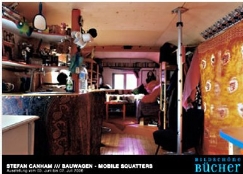Site created by Amplitude. |
||
Bauwagen/Mobile Squatters review
Bauwagen/Mobile Squatters, Stefan Canham – Peperoni Books, Price: €35
ISBN: 3-9809677-1-9
In the autumn of 2002 German police evicted “Bambule”, one of Hamburg’s alternative trailer parks, which had been tolerated by the local authorities since 1994 on a centrally situated plot of wasteland owned by the city. In the months to follow, the inhabitants and their supporters organised weekly protest marches through Hamburg. While media coverage was intense, its focus was on the police and demonstrators, rather than the trailers themselves. Consequently, it is from that date that photographer Stefan Canham’s interest in documenting the topic – by purely focussing on the homes themselves – was first aroused.
According to Canham, “Bambule” is part of a nationwide phenomenon. In the 1980s people began to use “Bauwagen” – narrow caravan-type trailers originally built to house builders on building sites – and there are currently over 100 such sites in German towns and cities, from Flensburg up on the Danish border down to Tuebingen and Munich. It is estimated that there may be as many as 10,000 people living in “Bauwagen”.
The book is effectively split into two parts: interior shots taken from a central point of view in colour (making up the majority of the book), contrasted with exterior views shot in black and white. Canham’s photographs of interiors are clearly meant to show how homely these trailers can be. They range from the ramshackle student kind of bedroom filled with books, guitars and all other kinds of junk with wires and cables hanging from every corner, to those that have been meticulously put into good order. All show the unique “personal touches” of the owner and each shot cleverly lets the viewer build up a picture of what the owner might look like, without revealing their identity. What is also remarkable is how different each trailer looks given their meagre dimensions, and how well equipped most are – many have stoves, stereos, telephones and computer equipment.
The exteriors, for the main part, offer a more stark contrast. The trailers are positioned on wasteland on the outskirts of cities and towns, obscured by clumps of trees and foliage or hidden by dilapidated buildings. These are homes on the margins of German society – as are their inhabitants, according to traditional prejudices.
The central idea behind Canham’s photographs is that people should reserve judgement about the inhabitants and judge these homes on their own merits – as alternative homes in alternative surroundings. Canham’s pictures overwhelmingly point out that these inhabitants –which include students, musicians, punks, hippies, actors and Tai Chi teachers – can be as house-proud as those people who live more conventionally and can equally be defined as a community as those living in a tower block.
“The central idea behind Canham’s photographs is that people should reserve judgment about the inhabitants and judge these homes on their own merits”

